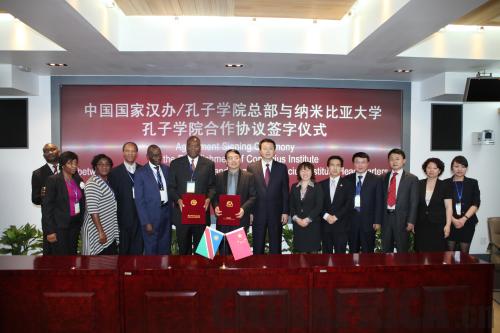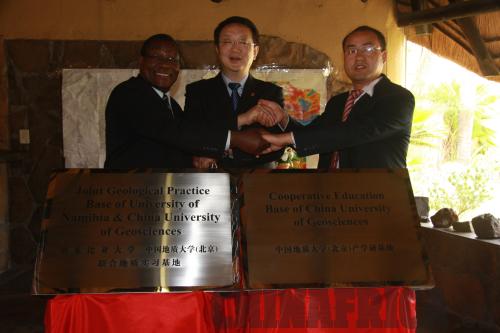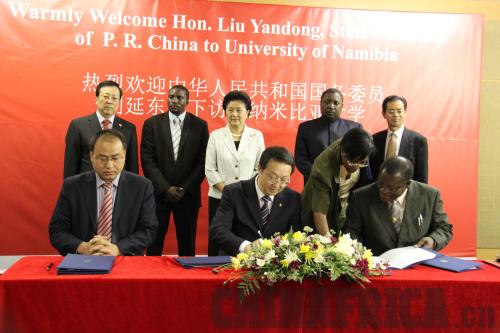|
 |
|
On May 15, 2012, the agreement of the establishment of the Confucius Institute at UNAM is signed (COURTESY PHOTO) |
Founded in 1952, China University of Geosciences in Beijing (CUGB) is a national key university under the direct auspices of the Ministry of Education. Over the past 60 years, it has developed from a geological college focused on a single discipline to a multi-disciplinary comprehensive university, offering courses in geology, natural resources, environment and geological engineering.
At present, CUGB has 18 schools, offering 47 undergraduate programs, 118 graduate programs, 37 doctoral programs and nine postdoctoral programs. It's one of China's main centers for educating geological researchers and professionals.
The university attaches great importance to international academic exchanges. CUGB signed a memorandum of understanding with the University of Namibia (UNAM) in 2006, and has since enjoyed six years of fruitful cooperation with the African institution. Two years ago, they partnered as part of the "20+20 Cooperation Project among China-Africa Universities."
The two universities' cooperative efforts are mainly focused on the disciplines of geology, natural resources, environment and geological engineering. These are fields in which CUGB excels and UNAM hopes to develop. The two sides plan to conduct substantial cooperative exchanges in three years' time or more. These exchanges will aim to strengthen teaching and academic research at UNAM, as well as establish a long-term partnership based on cooperation between the two universities.
 |
|
The Joint Geological Practice Base of UNAM and CUGB is unveiled in Namibia on December 1, 2011 (COURTESY PHOTO) |
Under this framework, the two institutions have also begun working with Chinese companies. This new cooperative effort named "1+1+N," with "1" standing for CUGB and UNAM respectively, while "N" stands for Chinese mineral exploration and development companies in Namibia, offers both universities centers from which to conduct practical geological research.
In 2010, CUGB helped UNAM build a basic geoscience laboratory. Last year, to enhance academic exchanges and provide students with better conditions, the two universities and the East China Mineral Exploration and Development Bureau agreed to establish the Joint Geological Practice Base in Namibia. On November 30, 2011, a memorandum of understanding was signed among the three during a visit to UNAM by a Chinese Government delegation headed by Chinese State Councilor Liu Yandong.
During this official visit, Liu, on behalf of the Chinese Government, presented UNAM with geology microscopes worth about one million yuan ($158,982.5). In addition, CUGB also helped UNAM build a geology microscope laboratory network management system to improve its laboratory management and efficiency.
Liu hopes the two sides can expand areas of cooperation. She says that, in addition to geosciences, the two universities could also cooperate in other areas, including curriculum design, basic course instruction, engineering and technology.
A letter of intent to jointly establish a Confucius Institute in UNAM was also signed by both institutions during Liu's visit. Liu hopes that the Confucius Institute will play a role in facilitating cultural exchanges between the two sides. The agreement to establish the Confucius Institute was signed on May 15, 2012, and preparatory work is now under way.
Currently, CUGB has an enrollment of 14,000 full-time students, 25,000 continuing education students, 12,000 independent college students, and 100 international students. The university started recruiting African students in 2004, and is now host to around 30 African students on its campus. Among them are five teachers from UNAM who are pursuing master or doctoral degrees with support from Chinese Government Scholarships and the Sam Nujoma Scholarship.
In 2013, the university plans to enroll 10 Chinese Government Scholarship students. International students at CUGB can also apply for Beijing Government Scholarships, which cover either full or partial tutition for international students studying or applying to study in Beijing.
 |
|
On November 30, 2011, a memorandum of understanding is signed among the three during Chinese Government delegation's visit to UNAM, which was headed by Chinese State Councilor Liu Yandong (middle in the second row) (COURTESY PHOTO) |
|